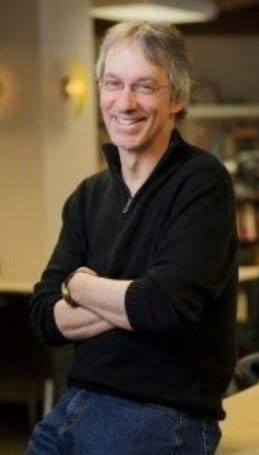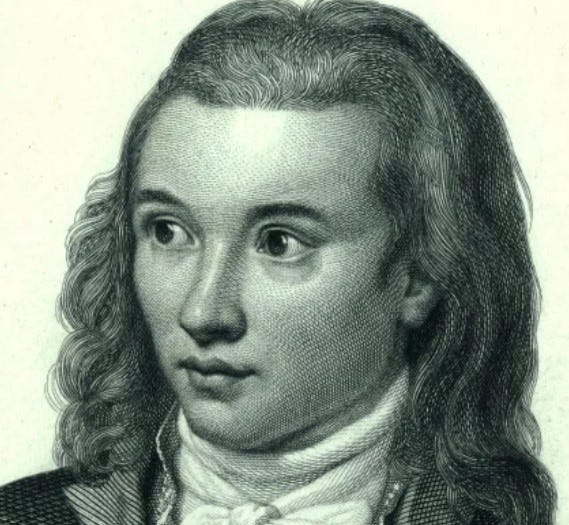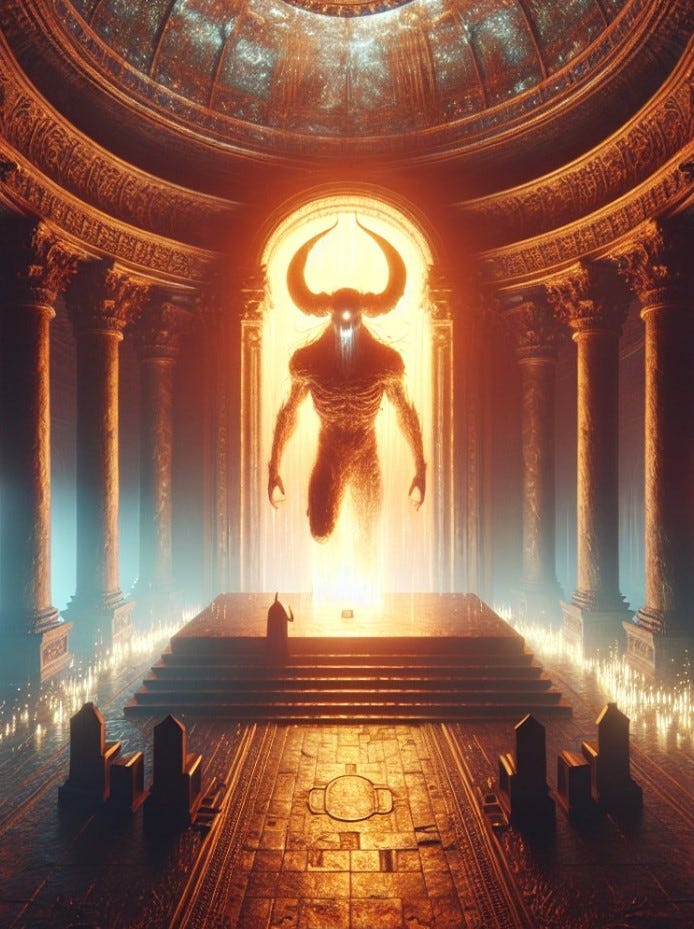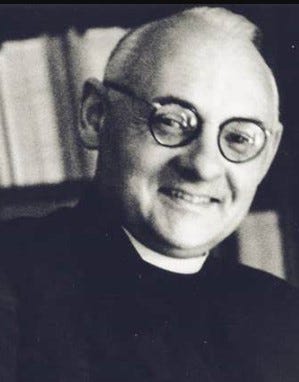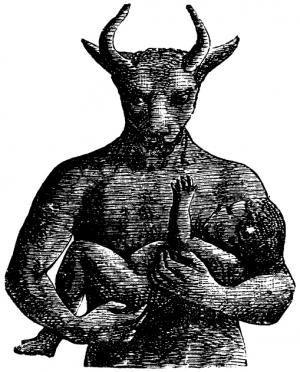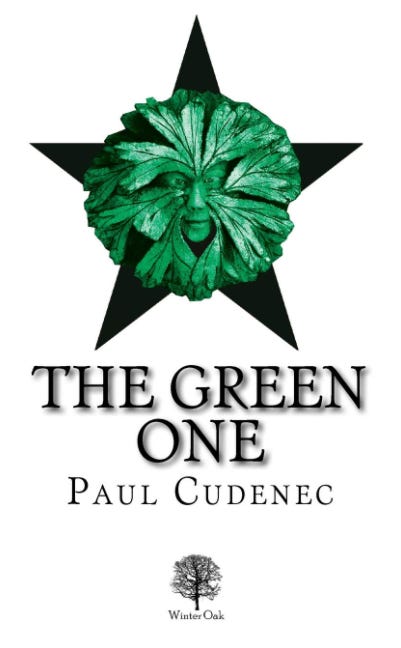For readers primarily interested in my political writing, this current exploration of the sophiological tradition via the pages of The Heavenly Country might not seem terribly relevant.
But in fact the ideas I have been discussing here are of fundamental importance for the building of our New Resistance against the criminocracy.
Their pertinence to the great struggle ahead of us is, indeed, expressed time after time in the pages of the book.
Editor Michael Martin (pictured) declares in the introduction: “We live in an age of untrammelled superstition: the hope that science will save us from ourselves and bless us with prosperity and, even, that it will allow us to overcome death.
“This is an age of the totalization of the technological and the technocratic, an age of the unreal, the artificial, the illusory, of the simulacra”. [1]
“In this paradigm, the human person is viewed as a machine among other machines, replete with updateable hardware, a myriad number of applications, and the promise of replaceable as well as changeable parts. I, human, iHuman…
“Accepting the human person as a machine ultimately distances the human person from himself, from the awareness of himself as a human person, as an integrally somatic, pneumatological and existential being.
“Yet it is the machine model (though few have the courage to name it as such) that is ascendant in our own cultural moment.
“We see this perhaps most clearly in the burgeoning gender reassignment industry, an industry not only of technological application, but also now fully integrated into the political, corporate, and entertainment complex”. [2]
Martin describes a long-term project of control and transformation of matter that was initially directed outwardly towards the exploitation of nature and the colonisation of peoples.
He adds: “It has now been turned onto the human subject himself, oftentimes with individuals allowing their own bodies to be colonized by the totalizing dictates of ideology”. [3]
Several ideas about how this historical process started and developed are advanced by authors featured in the book.
Artur Sebastian Rosman sees a seed in certain kinds of Protestant thinking, in which “God’s transcendence of creation is accentuated so as to almost form a complete break”. [4]
The poet Novalis, in his 1799 essay ‘Christendom or Europe?’, while acknowledging “the transitory blaze of heaven” in Protestantism’s beginnings, identifies a “corrosive influence” which led us into an age in which “the worldly has gained the upper hand”. [5]
He states: “The history of Protestantism shows us no great and splendid manifestations of the supernatural any more” [6] and argues that hatred of the Catholic Church had gradually extended into hatred of the Christian faith, of religion in general and then of “all objects of enthusiasm”.
“It made imagination and emotion heretical, as well as morality and the love of art, the future and the past. With some difficulty it placed man first in the order of created things, and reduced the infinite creative music of the universe to the monotonous clatter of a monstrous mill”. [7]
Novalis (pictured) depicts thinkers of the Enlightenment as “tirelessly busy cleaning the poetry of Nature, the earth, the human soul, and the branches of learning – obliterating every trace of the holy, discrediting by sarcasm the memory of all ennobling events and persons, and stripping the world of all colorful ornament”. [8]
The flat and rigid thinking regarded as “scientific” came to dominate our society, as Brent Dean Robbins explains in his essay.
“In our technological world; the call of the natural world can get drowned out by the abstract theoretical concepts that have increasingly come to replace our receptivity to the concrete claims of the phenomena that compose our life-world”. [9]
He says the Cartesian-Newtonian view – what Johann Wolfgang von Goethe calls “the gloom of the empirico-mechanico-dogmatic torture chamber” [10] – understands the world through a veil of mathematics and regards human perception as untrustworthy.
“It performs, in other words, what philosophers have come to call ‘reductionism’: it comes to explain the world of human experience by ‘reducing’ its meaning to causal events ‘behind’ the phenomena.
“For example, what you see are colors; but, in reality, there are ‘nothing but’ waves of light. Reductionism, in this sense, is the disease of ‘nothing-but-ness’. ‘Nothing-but-ness’ is another term for nihilism”. [11]
A similar conclusion is reached by Bruce V. Foltz, who argues that “we have a monstrous distortion of creation: nature as something bereft of divinity and grace… leaving qualities such as goodness and beauty merely subjective labels”. [12]
Analysing the work of novelist Fyodor Dostoevsky, he identifies a series of “unhappy, disappointed, Westernized intellectuals” in his fiction.
“These are figures whose hearts have been corrupted by their thoughts and by their attachment to their thoughts, and for whom created nature is an object of contempt (the battered and bitter Underground Man, for whom it is a realm of dumb necessity) or revulsion (Raskolnikov, who from within the Hell of his own making experiences nature as scorching and sulfuric, i.e., as itself infernal).
“These are nihilistic figures… cerebral, disembodied figures (shades, perhaps) believing only in the reign of the Man-God, humanity elevating itself to the status of world-creator”. [13]
Some go further than labelling this phenomenon merely nihilistic.
Foltz points to Sergei Bulgakov’s concept of a “diabolical economy… obscuring and debasing and disfiguring original creation”. [14]
And The Heavenly Country editor Martin evokes the powerful critique of modernity voiced by 20th century Welsh poet David Jones.
“Like Heidegger, Steiner, Huxley, and so many others who have raised concerns about the human, cultural, and spiritual costs of our infatuation with technology, Jones argues that we have made this technology into an idol, a Moloch-like demon he calls the Ram, and that this god demands the instrumentalization and subsequent sacrifice of human persons”. [15]
Martin describes Jones’ “condemnation of the anti-sophiology that rules modernity, a modernity that can no longer recognize what a human person is, what gender is, what marriage is or what is real”.
And he remarks: “This is truly a modernity in which ‘dead forms multiply’ and it is characterized by the fetishization of sterility”. [16]
He also reminds us of Nikolai Berdyaev’s 1935 warning that “the world threatens to become an organized and technicized chaos in which only the most terrible forms of idolatry and demon-worship can live”. And he adds, “That day is here”. [17]
So, how are we to bring down the demon Moloch and the modern techno-hell in which he has enslaved us?
Reviving and popularising the natural-spiritual perspective offered by sophiology could well be part of the answer.
Martin says his book “provides an antidote to the ontological poison with which we have all been infected” [18] and presents “a worldview that can heal the ontological, teleological and epistemological wounds from which our age so deeply suffers”. [19]
But the figure of Sophia can also act as a dynamic factor in our own relationships with existence, offering us guidance on the path to what Foltz terms Katharsis (purification of the heart) and a subsequent metanoia (change of heart) that would allow us to experience the sacred presence in nature and in others. [20]
He insists: “Only when we apprehend nature as divinely instituted, i.e., see it as creation, are we able to learn from it, to sense the divine wisdom interwoven throughout it.
“That is, only by means of askesis (understood not primarily as fasting and vigils, but purification of the heart) can nature be seen deeply and the divine wisdom reigning within it be revealed”. [21]
To reach this understanding, this gnosis, we need to be open to inspiration, writes 20th century theologian Hans Urs von Balthasar (pictured) – “a moment when the ‘spirit that contains the god’ (en-thusiasmos) obeys a superior command which as such implies form and is able to impose form”. [22]
“Such creative form, then, is God’s work, and the work of man only in so far as he makes himself available to the divine action without opposition, allowing God to act, concurring in his work.
“Such ‘art’ becomes visible in the Christian sphere in the life-forms of the chosen. In its exact sense, prophetic existence is the existence of a person who in faith has been divested of any intent to give himself shape, who makes himself available as matter for the divine action”. [23]
The divine action for which we all need to make ourselves available is that of fighting the evil of the dark enslaving empire that today dominates our society.
And the potential role of Sophia in inspiring us in this task is portrayed in the words of the 17th century English mystic Jane Lead, whose visionary encounter with “God’s Eternal Virgin-Wisdom” is described in the first of these essays.
Sophia warns of the “the Dragon and the Beast, with all his horned power… which the whole World hath worshipped and admired”.
This vile entity “hath long had his Time, to impose strange Laws, and Injunctions and hath been in Universally obeyed”.
Sophia declares that “Sorceries, Witchcrafts, and Deceits have worn out many Generations, who was ignorant of the Depths of this subtle Serpent” and have tricked them into accepting “this false usurped Power and Authority”. [24]
Sounds familiar!
But she tells Lead: “Be of good comfort, the Judge is nominated, the Jury is chosen, by whom the Verdict will be given; therefore be true to the Interest of my Son, who is appointed to judge the World in thee, and to cast out Hell, Sin and Death, the Beast and his retinue into the Lake, where there shall be no return out thence, to assault thee with their Dregs and Poysonous Floods.
“This is to be done by joining Issue and Power with me, whom am come to help thee against the great Leviathan, who makes war most, where he sees his Time of Reigning is almost worn out, and that he must have no more place”. [25]
There is a definite compatibility between all this and my own version of Sophia, whom I introduced in the opening essay.
I present here The Green One’s concluding statement as a parting encouragement, ahead of the completing footnote to this three/four-part series.
“I have been called to action and will not cease from mental fight. I ride into battle as Tammuz and Pachamama, as Great Pan and Grandmother Spider, as Brigid and Jack in the Green, as Diana and Dikaiosune, as Joan of Arc and the Queen of Elphame, as Cybele and Dionysus, as Oshún and Oannes, as Dodola and Jarilo, as viriditas and asha.
“And I ride into battle as much more than these. I am not just the sum of their parts, but the understanding of how they all represent the same vital force emerging through the human mind – the understanding, too, that this understanding is important and that it is itself part of the eternal wisdom of humanity, the Sophia Perennis.
“I am Sophia Perennis in active mode, in revolutionary mode, in the mode of destroying all that stands in the way of my reinstatement as the foundation of your thinking and your living.
“I am your determination to ditch the dead-souled industrial mindset that blocks your future”. [26]
See also:
The spirit of Sophia: wild air and wisdom
The spirit of Sophia: nature and grace
[1] Michael Martin, ‘Introduction: Sophiology: Genealogy and Phenomenon’, in The Heavenly Country: An Anthology of Primary Sources, Poetry, and Critical Essays on Sophiology, edited by Michael Martin (Kettering, Ohio: Angelico Press/Sophia Perennis, 2016), p. 1.
[2] Ibid.
[3] Martin, ‘Introduction’, in The Heavenly Country, p. 2.
[4] Artur Sebastian Rosman, ‘The Catholic Imagination: A Sophiology Between Scatology and Eschatology’, in The Heavenly Country, p. 380.
[5] Novalis, ‘Christendom or Europe?’, in The Heavenly Country, p. 91.
[6] Ibid.
[7] Novalis, ‘Christendom or Europe?’, in The Heavenly Country, p. 93.
[8] Novalis, ‘Christendom or Europe?’, in The Heavenly Country, p. 94.
[9] Brent Dean Robbins, ‘New Organs of Perception: Goethean Science as a Cultural Therapeutics’, in The Heavenly Country, p. 325.
[10]
Quoted in Erich Heller, The Disinherited Mind: Essays in Modern German Literature and Thought (Cambridge: Bowes and Bowes, 1952), p. 18, cit. Robbins, ‘New Organs of Perception’, in The Heavenly Country, p. 319.
[11] Robbins, ‘New Organs of Perception’, in The Heavenly Country, pp. 316-17.
[12] Bruce V. Foltz, ‘Nature and Divine Wisdom: How (Not) to Speak of Sophia’, in The Heavenly Country, p. 359.
[13] Foltz, ‘Nature and Divine Wisdom’, in The Heavenly Country, p. 356.
[14] Foltz, ‘Nature and Divine Wisdom’, in The Heavenly Country, p. 374.
[15] Michael Martin, ‘The Poetic of Sophia’, in The Heavenly Country, p. 400.
[16] Martin, ‘The Poetic of Sophia’, in The Heavenly Country, p. 401.
[17] Nicolas Berdyaev, The Fate of Man in the Modern World, trans. Donald A. Lowine (1935, reprt. Ann Arbor, Michigan: The University of Michigan Press, 1961), p. 127, cit. etc Martin, ‘The Poetic of Sophia’, in The Heavenly Country, p. 388.
[18] Martin, ‘Introduction’, in The Heavenly Country, p. 2.
[19] Martin, ‘Introduction’, in The Heavenly Country, p. 5.
[20] Foltz, ‘Nature and Divine Wisdom’, in The Heavenly Country, p. 356.
[21] Foltz, ‘Nature and Divine Wisdom’, in The Heavenly Country, p. 363.
[22] Hans Urs von Balthasar, ‘The Glory of the Lord: Volume 1: Seeing the Form’, in The Heavenly Country, p. 138.
[23] Ibid.
[24] Jane Lead, ‘A Fountain of Gardens’, in The Heavenly Country, p. 79.
[25] Jane Lead, A Fountain of Gardens, p. 78.
[26] Paul Cudenec, The Green One (Sussex, Winter Oak, 2017), pp. 185-86.
https://winteroak.org.uk/wp-content/uploads/2020/10/the-green-one-1.pdf
Source: https://paulcudenec.substack.com/p/the-spirit-of-sophia-against-moloch
Article courtesy of Paul Cudenac. https://paulcudenec.substack.com/

